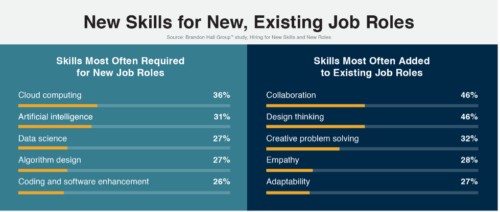
Are you struggling to find the right people to fill key roles within your organization? Do you find that your current employees are missing the skills needed to keep up with the changing needs of your industry? You’re not alone. Brandon Hall Group™ research has shown that new skills have shown up in as many as 90% of existing jobs for organizations. Most commonly:


With all the focus on upskilling and reskilling, it’s time to explore a practical, uncomplicated approach to closing the skills gap, empowering your employees, and driving business growth.
The Simple Formula for Closing the Skills Gap
Addressing the skills gap and empowering your workforce for organizational success can be achieved through a simple yet effective formula.
- Conduct a thorough skills gap analysis.
Identify the specific gaps and needs within your organization by comparing the current skills of your employees with the skills required for success in their roles. - Create a comprehensive strategy that aligns with your business goals.
This strategy should include a variety of training and development methods to accommodate different learning styles and preferences. - Reinforce a culture where employees take the reins of their professional growth.
Equip them with the tools they need, from training materials to mentors and opportunities for advancement.
L&D strategies often struggle because they try to fix everything instead of prioritizing for impact on results. The return to a more skills-focused approach to learning design will fail if you try to address every skill at the same level at the same time. Instead, focus on structures, process and approach.
Choose low-hanging fruit from among the skills your organization wants to develop. Choose one skill that is in need of minimal growth and one that is a larger gap. Ensure both are tied to a gap in results. Of course, if your organization has yet to define your skills taxonomy, start there.
By focusing on the most critical skills, aligning training with business objectives, and creating a culture that encourages learning and development, organizations can ensure that their employees are prepared to succeed in their roles and help the organization succeed in the global marketplace. This strategic approach can help organizations stay ahead in a world that is constantly changing. But if organizations don’t address the skills gap, they risk falling behind.
Technology gives organizations a competitive edge in talent development. L&D teams should adopt experiential learning methods like simulations and project-based learning, allowing employees to apply skills in realistic scenarios and receive immediate feedback. AI and mobile learning platforms help deliver personalized learning at scale. Data analytics can identify skill gaps and recommend tailored learning paths, increasing engagement by focusing on relevant skills for each employee’s role and aspirations. A learning management system (LMS) is central to this approach, providing a centralized platform for training materials, progress tracking, and personalized learning path creation.
To build a skills-based organization, L&D teams must cultivate a culture that values and encourages continuous learning. This involves creating an environment where employees feel supported in their learning endeavors and have access to a wide range of learning resources. It’s not just about providing training programs; it’s about creating an environment that encourages curiosity, growth, and adaptability.
Fostering a growth mindset can be game changing. This involves instilling the belief that abilities are not fixed but can be developed through dedication and effort. Encouraging your team to embrace challenges, learn from setbacks, and step out of their comfort zones will create a workforce that is resilient and adaptable, ready to face the ever-evolving business landscape.
To further explore all the ways Litmos can help you on your journey, download the eBook: Minding the Gap: L&D Solutions for the Skills Gap.